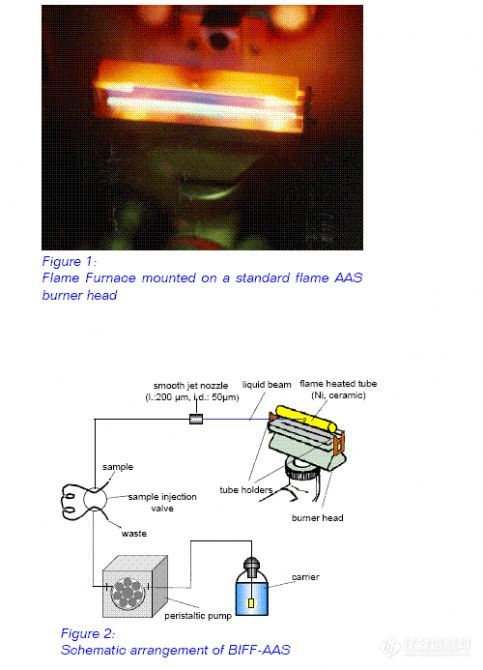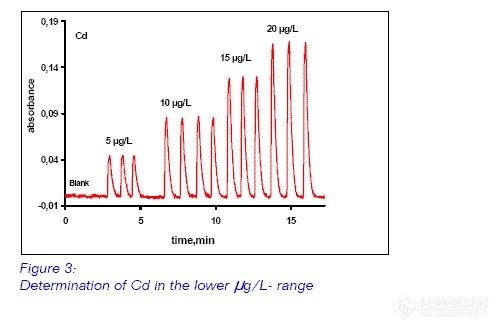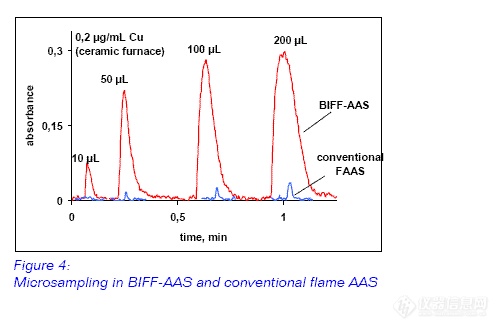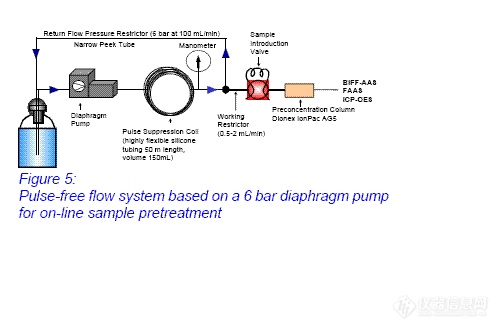


第1楼2005/04/02
The experiments showed that a beam is stable over a
distance of at least 15 cm if its speed is higher than
about 12 m/s. Using a nozzle of 50 :m inner diameter,
a 1.42 mL/min flow rate is necessary to reach this
speed. The typical shape of a smooth jet nozzle is a
cylinder with a ratio length/diameter > 3. The pressure drop of such a nozzle is less than 0.5 bar which
allows the use of low-pressure pumps, for instance a peristaltic pump, for the beam generation.
The requirements for the material of the tube furnace include good stability and chemical resistance
against the corrosive conditions of an acetylene/air flame and water and acid vapors at temperatures higher
than 1000 /C.
Suitable tube materials are pure nickel, super alloys or non-porous Al2O3 ceramic. To increase the
temperature inside the furnace and to achieve a more reducing atmosphere, a tube with 4 or more
additional holes located on the bottom side is used.
Currently, 25 elements have been determined
using BIFF-AAS, of which 17 elements (Ag, As,
Au, Bi, Cd, Cu, Hg, In, K, Pb, Pd, Rb, Sb, Se,
Te, Tl, Zn) exhibit an improved power of
detection from 6 fold to 202 fold compared to
conventional FAAS [1]. The standard deviation
amounts to 1.7 - 4.0 % (N = 12; 50 :L
samples). Fig. 3 shows the signals of Cd sample
in the low :g/L range measured with BIFFAAS.
第2楼2005/04/02

The sample is injected via a sample introduction
valve into a carrier stream as in all flow injection
techniques including HPLC. Because of this,
even sample volumes as small as 10 :L can be
easily applied. Fig. 4 shows the determination of
copper with increasing sample volumes and
using BIFF-AAS as well as conventional flame-
AAS. With 10 :L samples a clear Cu signal
appears in case of BIFF-AAS but not when
using the normal flame AAS. Working with a
peristaltic pump allows a continuous sample
introduction to be maintained. Generating the
liquid jet with the aid of a high-pressure pump,
BIFF-AAS can be applied as a simple, efficient
interface between HPLC separation techniques
and elemental determinations by flame-AAS.
第3楼2005/04/02

To fill the gap in the pressure range between
HPLC and peristaltic pumps a novel pump
system based on a 6 bar low cost diaphragm
pump has been developed (Fig. 5). The unavoidable
strong pulsation has been overcome by
using 50 m (2 mm i.d.) of highly flexible silicone
tubing as a pulse suppression coil. This results
in a smooth pulse free continuous flow whereby
the pump delivers 100 ml/min in circulation. For
analytical flow injection a restrictor is connected
to a splitting point in the cycle to tap off the
flow needed, down to 0.2-5.0 ml/min. The
higher pressure of the diaphragm pump
compared to the peristaltic pump permits the
use of common HPLC-columns or low-pressure
chromatography columns for online-sample
pretreatment like preconcentration of traces or
matrix separation. This system was successfully
applied for the beam generation in BIFF-AAS
and for on-line sample pretreatment in
conventional AAS and ICP-OES respectively.